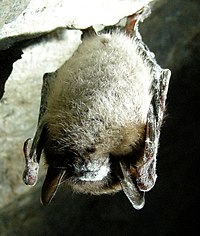
Photo from wikipedia
Although it is well documented that infectious diseases can pose threats to biodiversity, the potential long-term consequences of pathogen exposure on individual fitness and its effects on population viability have… Click to show full abstract
Although it is well documented that infectious diseases can pose threats to biodiversity, the potential long-term consequences of pathogen exposure on individual fitness and its effects on population viability have rarely been studied. We tested the hypothesis that pathogen exposure causes physiological carry-over effects with a pathogen that is uniquely suited to this question because the infection period is specific and time limited. The fungus Pseudogymnoascus destructans causes white-nose syndrome (WNS) in hibernating bats, which either die due to the infection while hibernating or recover following emergence from hibernation. The fungus infects all exposed individuals in an overwintering site simultaneously, and bats that survive infection during hibernation clear the pathogen within a few weeks following emergence. We quantified chronic stress during the active season, when bats are not infected, by measuring cortisol in bat claws. Free-ranging Myotis lucifugus who survived previous exposure to P. destructans had significantly higher levels of claw cortisol than naïve individuals. Thus, cryptic physiological carry-over effects of pathogen exposure may persist in asymptomatic, recovered individuals. If these effects result in reduced survival or reproductive success, they could also affect population viability and even act as a third stream in the extinction vortex. For example, significant increases in chronic stress, such as those indicated here, are correlated with reduced reproductive success in a number of species. Future research should directly explore the link between pathogen exposure and the viability of apparently recovered populations to improve understanding of the true impacts of infectious diseases on threatened populations.
Journal Title: Conservation Biology
Year Published: 2017
Link to full text (if available)
Share on Social Media: Sign Up to like & get
recommendations!